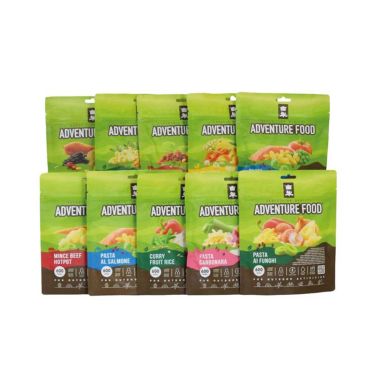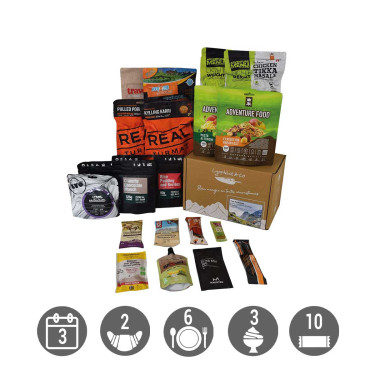-
Free delivery on purchases of €70 or more to relay points in Europe
-
Enjoy -10% on the Backpacking Food Category with the code: TREKKING10
Guide: How to Prepare a Freeze-Dried Meal?
Used to hiking trails, trail running, bikepacking, or even bivouacking, you might think this article isn’t really necessary and can be summed up in one sentence: boil water… Think again! While preparing a freeze-dried meal is simple, it’s still an art! Here are some reminders and tips for properly preparing a freeze-dried meal while hiking.
Hiking pack - 7 days - Freeze-dried food and snacks

Hiking Pack - 3 days - Freeze-dried food and snacks

Boiling Water...
So yes, you will boil water with your preferred stove, using solid, liquid, or gas fuel.
About the Water:
First of all, if you're using water from a source in the field, make sure to filter it. Although boiling will purify the water, this process does not remove suspended particles that might "season" your meal in a rather unpleasant way (I’m making this point, which may seem obvious, in memory of an old YouTube video where the protagonist collected water with his pot before boiling it, without mentioning the debris in the water). Filtration and purification are key to a good base for your freeze-dried meal.
The Subtle Art of Rehydration
- The right amount of water
You’ll add the amount of water indicated by the manufacturer. Generally, lines inside or outside the pouch are printed to show the level to which you should fill the water, depending on the brand. If these lines are absent or located outside, the measurement will be less precise, which is why it’s useful to carry a graduated water bottle to ensure you’re heating the right amount of water without wasting fuel.
- Mix Well
Another important step is to mix thoroughly to ensure the entire meal is moistened and no dry bits remain. A long-handled spoon can help you reach all corners of the pouch. - Let it Rest
Finally, let the meal rehydrate for the necessary amount of time after sealing the pouch. Rehydration takes longer for dehydrated meals (dried with heat) compared to freeze-dried meals (dried with cold).
Tips to Rescue a Mishap
If, despite all your precautions, the meal seems too dry when you open the pouch, add a bit of hot water and stir. Conversely, if the recipe is too wet, you can fix it by briefly heating it in a pan (if you have one, of course).
Cooking Equipment
This paragraph may not be popular with ultralight enthusiasts, but bringing a few utensils (of reasonable weight, of course) can not only enhance your meals but also sometimes help recover a meal that’s too “wet” (as mentioned earlier) by cooking it briefly in a pan or pot over moderate heat.
Extra Tips to Transform a Freeze-Dried Meal
I invite you to consider your freeze-dried meals as a true cooking moment. Feel free to add fresh ingredients, season them with a little spice kit, or even mix recipes and sauté them. The “ready-to-eat” part doesn’t prevent culinary improvisation. Be creative and enjoy yourself!
I like to add a few ingredients to my freeze-dried meals, for example, with the classic mac and cheese, I rehydrate a bit of jerky (dried meat) and then sauté it with onions or shallots. I sometimes bring one or two fresh eggs, which I place in the wide-opening bottle of a Nalgene-type bottle. I can also add a source of fat (often duck fat, which is an excellent source of fat that easily adds calories to the menu).
Let's Not Forget Dessert
Adding quick sugars provides an undeniable energy boost and a bit of comfort after a busy day. If you're including a freeze-dried dessert in your menu, remember to plan ahead for its preparation. While most recipes can be rehydrated with cold water, some require hot water. It’s always a shame to eat a lukewarm cream when you prefer it cold, so before starting to heat your main dish, prepare your dessert and give it time to cool, either by opening the pouch or, if you're near a stream, submerging the sealed pouch in the water. This way, you'll get the most out of your sweet brea
Keeping it Warm with a DIY Sleeve (Tutorial)
In cold weather and at higher altitudes, keeping your meal warm, even during the waiting period when rehydrating, can be crucial. It’s very easy to make a pouch (called a "cosy" by the Anglo-Saxons) that will insulate your freeze-dried meal. Use mylar insulation sheets, like the ones placed on windshields in winter, and take the template of your largest freeze-dried meal pouch. Cut two mylar sheets, ensuring one is slightly longer than the other to create a flap, and then use gaffer tape to assemble them into an envelope shape. It’s simple, inexpensive, and will allow you to keep your freeze-dried meal warm in unfavorable weather conditions.
In conclusion
As you can see, you do need to add water to rehydrate a freeze-dried meal, but not just any way. While "ready-to-eat" doesn’t mean you can’t be creative with your meal, equipping yourself well but minimally allows you to properly prepare and enjoy your freeze-dried meal in good conditions.
Yves JEAN, passionate about hiking and bushcraft
"I have been interested in survival techniques and bushcraft, as well as outdoor gear, for over 25 years: making fire, building shelter, using axes, knives, and saws efficiently and safely, navigating with a map and compass, tracking animals... A fan of open canoeing (or Canadian canoeing), I enjoy family canoe trips, particularly with my daughter."
A Word About Lyophilise & Co 🌶
Based in Lorient, Lyophilise & Co is the go-to reference for freeze-dried meals and high-quality outdoor gear. Whether you're a hiker, skipper, trail runner, bushcraft enthusiast, or bivouac lover, we offer a wide range of technical products tailored to all your adventures. With over 2,000 items available, we support your expeditions in France and abroad.
If you have any questions, our experts are here to help and will gladly assist you:
☎ +33 (0)2 97 87 23 73
✉ team[at]lyophilise.com
We also have a showroom open Monday to Friday:
📍 6 bis rue du Sous-Marin Vénus, 56100 Lorient, France
Related posts
-
 Food during the Marathon des Sables, by Carole Pipolo
We interviewed Carole Pipolo, founder of Outdoor And News and partner of Lyophilise & Co, to ask her about...Lire la suite
Food during the Marathon des Sables, by Carole Pipolo
We interviewed Carole Pipolo, founder of Outdoor And News and partner of Lyophilise & Co, to ask her about...Lire la suite -
 Sailing - What to Eat?
In this article, dive into the world of provisioning with freeze-dried recipes, along with their alternatives and...Lire la suite
Sailing - What to Eat?
In this article, dive into the world of provisioning with freeze-dried recipes, along with their alternatives and...Lire la suite -
 Special Volvo Ocean Race
Posted in: Food2024-11-15What sailors eat during the race!Lire la suite
Special Volvo Ocean Race
Posted in: Food2024-11-15What sailors eat during the race!Lire la suite -
 Special Vendée Globe - What Do Skippers Eat?
Posted in: Food2024-11-15For weeks, the skippers of the Vendée Globe have been meticulously preparing their onboard provisions, and we thank...Lire la suite
Special Vendée Globe - What Do Skippers Eat?
Posted in: Food2024-11-15For weeks, the skippers of the Vendée Globe have been meticulously preparing their onboard provisions, and we thank...Lire la suite -
 How to Prepare Your Nutrition for a Self-Supported Race Like the Marathon des Sables?
2024-11-15Wondering what food to choose and how to prepare your freeze-dried meals during the race? This article will provide...Lire la suite
How to Prepare Your Nutrition for a Self-Supported Race Like the Marathon des Sables?
2024-11-15Wondering what food to choose and how to prepare your freeze-dried meals during the race? This article will provide...Lire la suite















Leave a comment